Your 7-Day Weekly Meal Plan Kid-Friendly Strategy Just Got a Major Science Upgrade (And Your Sanity Will Thank You)

I used to think I needed 30 different dinner ideas to be a good mom. Pinterest boards full of color-coordinated bento boxes, Instagram feeds of perfectly plated family dinners – I was drowning in meal planning perfection. Then I discovered something that completely changed how I approach feeding my family: there’s actual science behind why kids reject certain foods, and once you understand it, everything gets so much easier.
This isn’t another Pinterest-perfect meal prep guide that’ll leave you exhausted and defeated by Wednesday. Instead, I’m sharing what actually works when you’re dealing with real kids who think vegetables are the enemy and your toddler’s idea of a balanced meal is three different shades of beige crackers.
Here’s the thing that blew my mind: families who rotate between just 3 basic meal templates have higher nutritional consistency and way less stress than those trying to create completely new meals every single day. Who knew that being “boring” was actually the secret to success?
Table of Contents
- Why Your Kid’s Brain Rejects “Healthy” Food (It’s Not Personal)
- The Smart Parent’s Guide to Batch Cooking Without Losing Your Mind
- Turning Dinner Into Cultural Adventures Your Kids Actually Want
- Building Meal Planning Habits That Stick (Even During Chaos)
TL;DR
- Kids need to see new foods 15-20 times before they’ll even consider trying them – but most of us give up after attempt number three
- That 3 PM meltdown? It’s biology, and you can work with it instead of against it
- One protein source can become 4-5 different meals (and your kids won’t even notice it’s the same chicken from Sunday)
- Shopping seasonally can cut your grocery budget by 40% while teaching kids that food doesn’t magically appear in stores year-round
- Three meal templates beat 30 different recipes every single time
- Kids who help cook are more likely to actually eat the food (even if your kitchen looks like a tornado hit it afterward)
Why Your Kid’s Brain Rejects “Healthy” Food (It’s Not Personal)
My daughter would literally gag at the sight of mushrooms. I thought she was being dramatic until I learned that kids’ taste buds are actually more sensitive than ours – way more sensitive. What tastes mildly earthy to me can taste overwhelmingly bitter to her developing palate. Suddenly her dramatic mushroom reactions made perfect sense.
Understanding how children’s brains work reveals why our traditional “just try one bite” approach usually fails spectacularly. Their neurological wiring prioritizes different things than adult brains – texture and how food looks matter more to them than whether it’s packed with vitamins. When you work with their brain development instead of fighting it, food acceptance becomes dramatically easier.
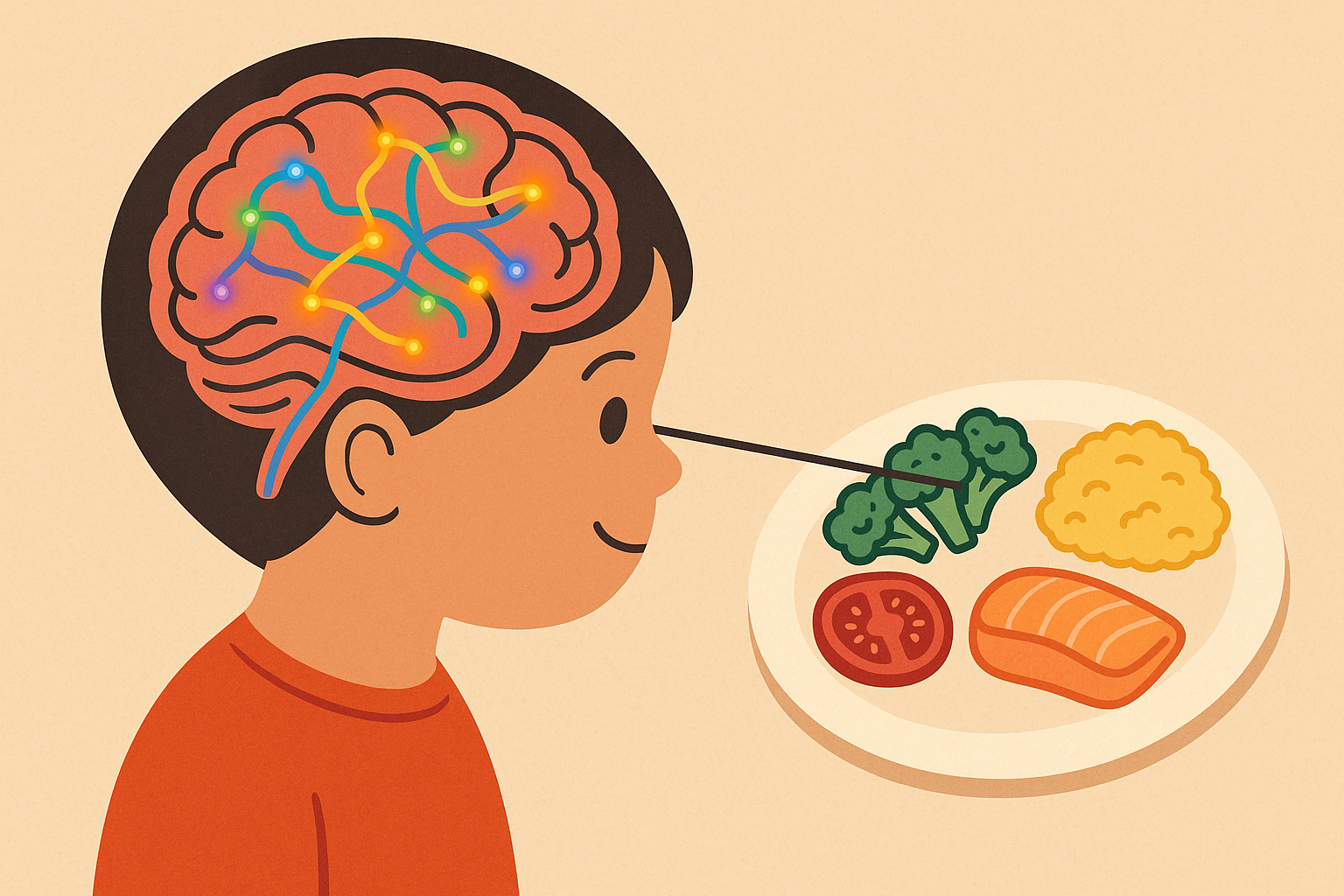
Understanding the science behind children’s food preferences is crucial for successful family meal planning, and research shows that working with their natural development rather than against it is key to success.
The Real Reason Kids Are “Picky” (Spoiler: It’s Survival Instinct)
Kids aren’t being difficult when they reject new foods – their brains are literally protecting them from what might be dangerous. In caveman times, this kept them alive. In modern kitchens, it keeps them from eating your carefully prepared quinoa salad.
Children’s brains prioritize texture, temperature, and visual presentation over nutritional content when deciding if something is “safe” to eat. This isn’t defiance – it’s biology doing its job.
The 15-Touch Rule That Changes Everything
Here’s what nobody tells you: kids need to see a new food 15-20 times before their brain decides it’s safe to try. Most of us parents throw in the towel after attempts two and three. We’re quitting right before the magic happens.
I used to think my daughter was just being stubborn about broccoli. Turns out, her brain needed to see it in different forms across multiple meals before deciding it wasn’t going to poison her. Now I put new vegetables in 3 different meals throughout the week – raw on Monday, roasted Wednesday, hidden in soup Friday. I keep a simple tracking sheet (nothing fancy, just checkmarks on a piece of paper stuck to my fridge) and celebrate “brave looking” instead of demanding clean plates.
According to research from Your Kid’s Table, families attempting 3-4 family meals per week where everyone eats a version of the same thing see significantly better food acceptance rates than those trying to coordinate identical meals seven nights a week.
The magic happens around exposure 12-15. That’s when you’ll see the shift from automatic “YUCK!” to curious investigation. Last week, my son actually picked up a piece of bell pepper and sniffed it. I nearly fell off my chair, but I played it cool.
This approach aligns perfectly with what nutritionists recommend in their 5 simple ways to beat bloat and improve digestion, where they emphasize introducing variety gradually to support children’s digestive development.
Temperature Is Your Secret Weapon
This blew my mind: my son who refused cooked carrots would demolish them straight from the fridge the next morning. Same carrot, different temperature, completely different reaction.
Temperature affects how taste buds perceive sweetness and bitterness. I started serving the same vegetable at different temperatures throughout the week and mapping his preferences like some kind of food scientist mom.
Cold cucumbers? Loves them. Warm cucumbers in soup? Absolutely not. But roasted bell peppers? Suddenly acceptable, while raw ones get the stink eye.
Take carrots as a perfect example: Monday – serve raw carrot sticks with ranch, Wednesday – include diced carrots in warm chicken soup, Friday – offer roasted honey carrots as a side dish. Same vegetable, three completely different experiences for their developing taste buds.
Timing Meals With Your Kid’s Internal Clock
Every parent knows about the 3 PM crash, but most don’t realize it’s actually an opportunity. Kids’ natural resistance to new foods drops during this energy dip. Their brains are less vigilant, more open to trying things.
Children’s digestive systems and appetite hormones follow predictable daily patterns that most meal plans completely ignore. Working with their circadian rhythms instead of against them eliminates most mealtime battles.
Why Breakfast Sets the Tone for Everything
Morning cortisol in kids is actually higher than in adults – their little systems are primed for action. But feed them sugary cereal, and you’re setting up a blood sugar rollercoaster that ends in tears (theirs and yours, let’s be honest).
Children’s naturally elevated morning cortisol requires specific nutrients to prevent that awful afternoon energy crash that ruins everyone’s day. Getting breakfast right means your kid might actually show up to dinner hungry instead of hangry.
I aim for 15-20g protein at breakfast now. Scrambled eggs with cheese, Greek yogurt with nuts, even leftover chicken in a breakfast wrap. The difference in afternoon behavior is remarkable. No more hangry meltdowns at 4 PM, and they actually want to eat dinner instead of melting down on the kitchen floor.
For parents looking to establish better morning routines, our guide on how to cook delicious oatmeal everytime provides protein-rich breakfast options that work perfectly within this framework.
| Time | What’s Happening in Their Brain | What Actually Works | What to Avoid (Trust Me) |
|---|---|---|---|
| 6-8 AM | High cortisol, ready for fuel | 15-20g protein + complex carbs | Sugary cereals (hello, sugar crash) |
| 10-11 AM | Energy peak | Light snack if needed | Heavy meals they won’t finish |
| 12-1 PM | Natural hunger window | Balanced lunch with variety | Rushing them through eating |
| 3-4 PM | Energy dip, lower food resistance | Strategic new food introduction | High sugar snacks that ruin dinner |
| 5-7 PM | Winding down for the day | Familiar foods, family connection | Food battles (nobody wins these) |
The 3 PM Sweet Spot Nobody Talks About
I use this 3-4 PM window strategically now – apple slices with almond butter, hummus with vegetables they’ve rejected at dinner, or new fruits they haven’t tried. The key is complex carbs plus protein, and timing it so there’s still 2 hours before dinner.
Sometimes my kids will try things at 3 PM that they’d throw on the floor at dinnertime. Their brains are just wired differently at different times of day.
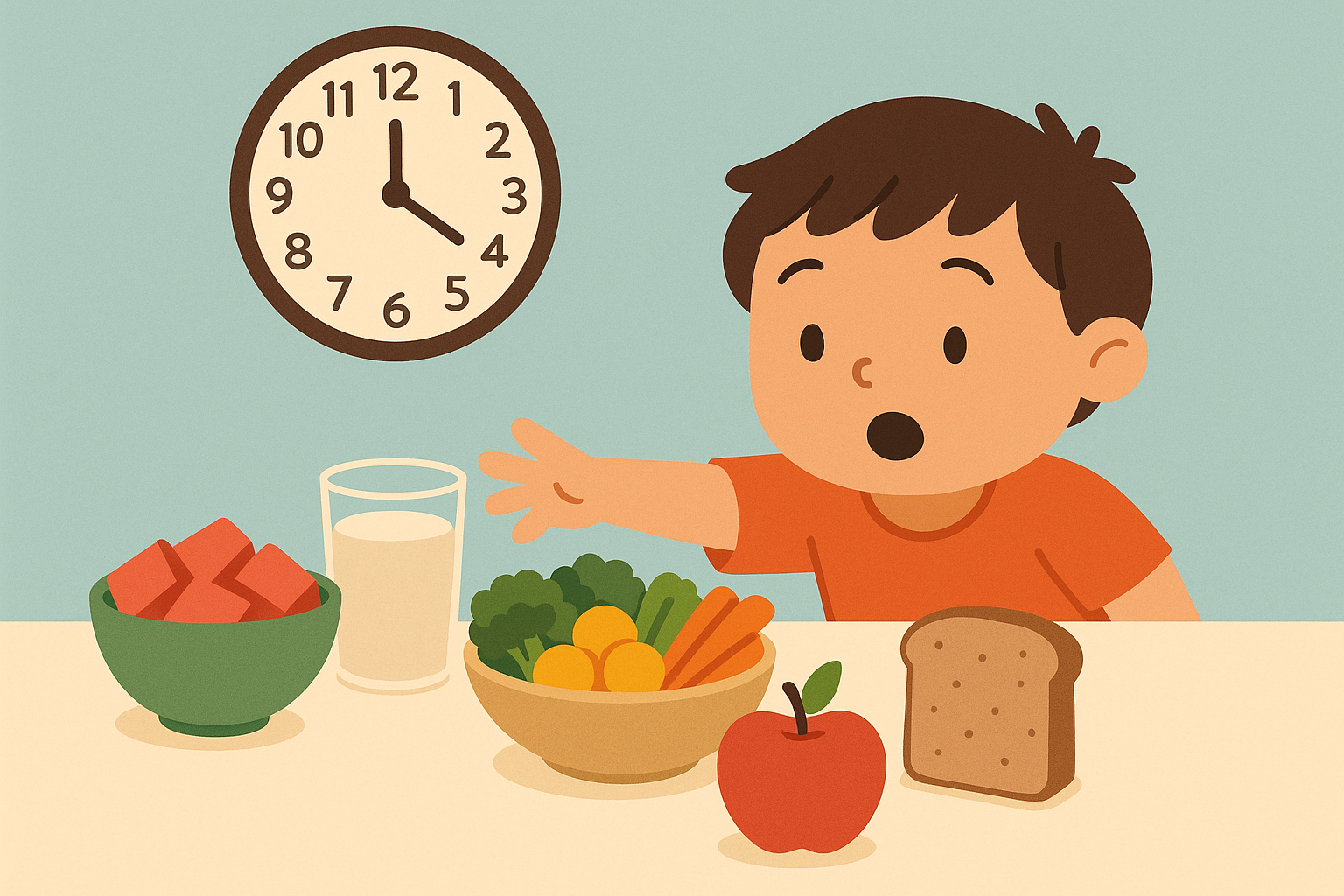
Creating Positive Food Memories (Not Food Trauma)
I had to unlearn everything about “finishing your plate.” Turns out, pressure creates stress hormones that literally make food taste worse to kids. Their taste buds become less sensitive under stress, which explains why dinner battles make everything worse.
Every meal creates lasting emotional associations that influence lifelong eating patterns. High-stress mealtimes create negative food associations that can persist for decades – and nobody wants their kid in therapy talking about how Mom made them eat broccoli.
The No-Pressure Zone That Actually Works
Now I follow the “no pressure” rule – I offer food without expectation. New foods appear on plates without fanfare. Sometimes they try it, sometimes they don’t. But there’s no negotiation, no bribing, no airplane noises. Just food, available if they want it.
We also created positive mealtime rituals that have nothing to do with eating – sharing the best part of our day, telling silly stories, or playing “guess the ingredient.” Suddenly dinner became something they looked forward to instead of dreaded.
Last week, my 4-year-old said, “Mom, this tastes like sadness” about my quinoa attempt. Instead of getting frustrated, we laughed about it and talked about what foods taste like happiness instead. Now “sadness quinoa” is a family joke, and he’s actually more willing to try new grains because we made it fun instead of stressful.
The Smart Parent’s Guide to Batch Cooking Without Losing Your Mind
Let me be real with you: my meal prep photos look nothing like Pinterest. There’s usually dried quinoa stuck to my counter, at least one kid crying in the background, and I’m pretty sure I haven’t washed my hair in two days. But you know what? This system still works.
Most families approach meal planning as a daily decision-making process, which is exhausting and expensive. Strategic batch preparation can reduce your prep time by 60% while actually increasing meal variety through smart transformations.
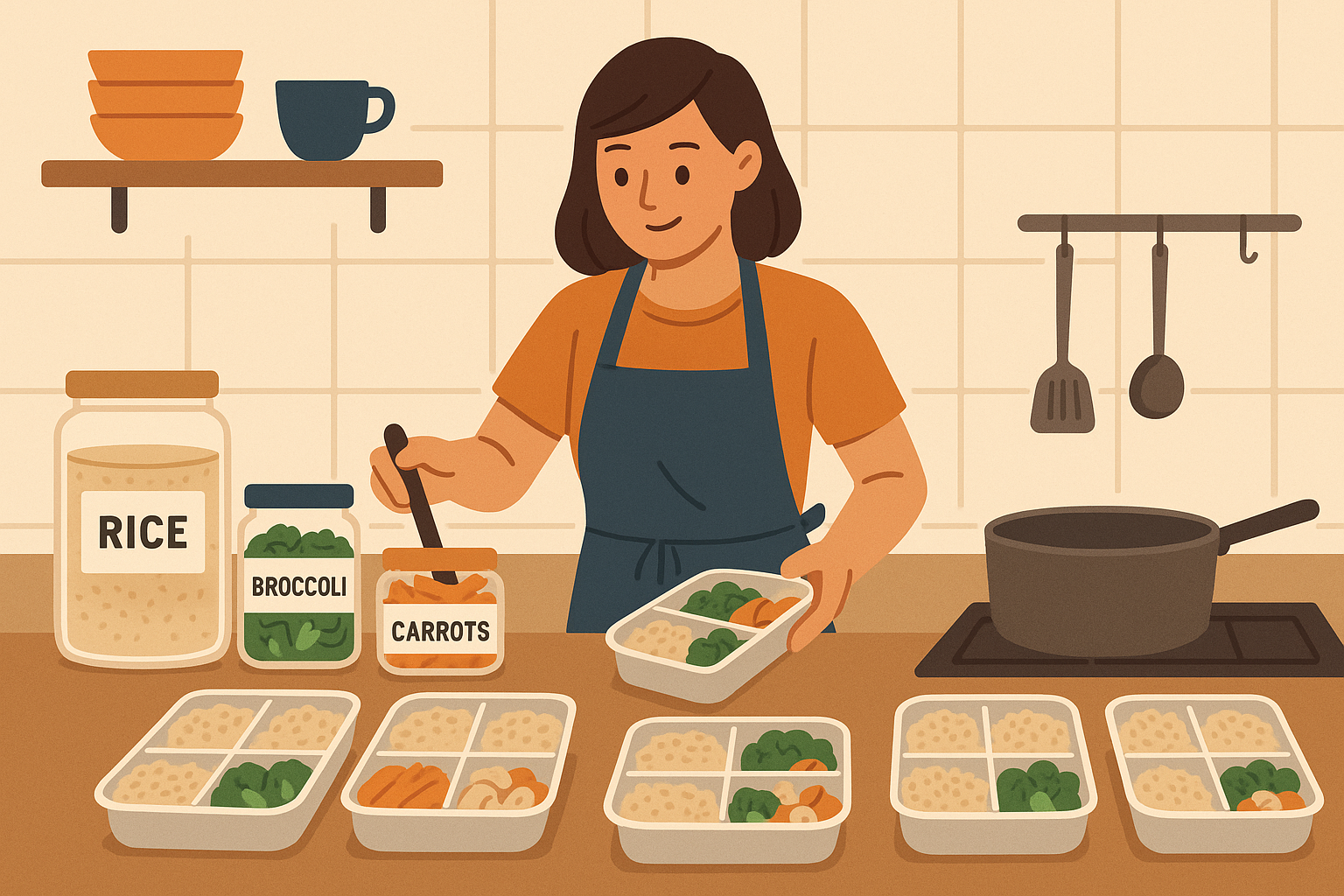
The Base-Plus-Variable System That Saves Your Weeknights
Sunday afternoon, I cook 3 pounds of chicken thighs (cheaper and more forgiving than breasts). Plain seasoning – just salt, pepper, garlic powder. Nothing fancy, because fancy is the enemy of getting dinner on the table.
Creating foundational components that can be transformed throughout the week gives you the variety kids crave while maintaining the familiarity their brains need. This system works because kids want both predictability and novelty – familiar ingredients presented in new ways.
One Protein, Five Meals (And Your Kids Won’t Even Notice)
Monday: Shredded into tacos with different toppings for each kid
Tuesday: Diced into chicken noodle soup
Wednesday: Sliced over pasta with marinara
Thursday: Cold in sandwiches with avocado
Friday: Chopped into fried rice with frozen vegetables
Same protein, completely different meals. The kids see variety, I see sanity preserved. The secret is in the transformation – different textures, temperatures, and flavor profiles make it feel like entirely different foods.
This approach mirrors what “Lifehacker” recently highlighted in their summer meal planning guide, noting how successful parents create weekly menus that provide “both choice and predictability” – exactly what this system achieves.
Vegetable Prep That Multiplies Your Options
I roast massive sheet pans of root vegetables every Sunday – sweet potatoes, regular potatoes, carrots, onions. Olive oil, salt, pepper, 425°F until they’re caramelized and smell amazing.
These become:
– Monday: Warm in grain bowls
– Tuesday: Blended into soup (kids can’t pick them out)
– Wednesday: Cold in salads
– Thursday: Reheated as side dishes
– Friday: Mashed into different textures for the toddler
Different preparations hit different sensory preferences. Some kids love the crispy edges of roasted vegetables but hate them steamed. Others prefer them pureed in soup where they can’t see the individual pieces and stage a revolt.
One batch of roasted butternut squash becomes: Monday’s warm side dish, Tuesday’s creamy soup base (just add broth and blend), Wednesday’s cold cubes in a grain salad, Thursday’s mashed version for the baby, and Friday’s diced addition to pasta sauce. Five completely different meals from one hour of Sunday prep – while I drink coffee and listen to a podcast.
For parents wanting to expand their vegetable repertoire, learning how to cook fresh green beans and other seasonal produce can dramatically increase your batch cooking options while keeping costs down.
The Hidden Economics of Smart Shopping
I started tracking cost per serving versus key nutrients in a simple spreadsheet. Sounds nerdy, but it changed everything about how I shop and stopped me from buying $6 organic kale that would wilt in my fridge while my kids ate goldfish crackers.
Traditional budgeting focuses on cost per meal rather than cost per nutrient, missing opportunities to maximize family health while minimizing the grocery bill that makes you cry.
Nutrient Density Math That Actually Matters
Frozen spinach costs $1.50 and provides iron, folate, vitamin K, and vitamin A for 6 servings. Fresh spinach costs $3.00 for the same nutrients in 3 servings, plus the guilt when half of it turns into green slime in your crisper drawer.
Eggs consistently score highest – protein, choline, vitamin D, B vitamins, all for about 25 cents per egg. Canned salmon beats fresh for omega-3s per dollar. Dried beans destroy meat on protein cost-effectiveness, though good luck getting your toddler excited about lentils.
This isn’t about being cheap – it’s about being strategic with your nutrition budget so you can afford the organic strawberries your kid will actually eat.
| Food Item | Cost per Serving | Key Nutrients | Why Kids Might Actually Eat It |
|---|---|---|---|
| Eggs | $0.25 | Protein, Choline, Vitamin D, B vitamins | Versatile – scrambled, hard-boiled, hidden in muffins |
| Frozen Spinach | $0.25 | Iron, Folate, Vitamin K, Vitamin A | Invisible in smoothies and pasta sauce |
| Dried Beans | $0.15 | Protein, Fiber, Iron, Folate | Texture can be tricky, but great in soups |
| Canned Salmon | $0.75 | Omega-3s, Protein, Vitamin D | Mix with pasta – they think it’s tuna |
| Sweet Potatoes | $0.50 | Vitamin A, Fiber, Potassium | Naturally sweet, roast until crispy |
| Greek Yogurt | $0.60 | Protein, Probiotics, Calcium | Mix with fruit, use as sour cream substitute |
Seasonal Eating That Saves Money (And Teaches Kids About Real Food)
Summer tomato week in August when they’re $1/pound instead of $4. Fall squash experiments when butternut squash is everywhere and you’re tired of pumpkin spice everything. Spring asparagus adventures when it’s actually affordable instead of $6/pound.
I plan themed weeks around seasonal abundance. The kids get excited about “strawberry week” in June or “apple week” in October. They start recognizing seasons by what appears in our meals, connecting food to natural cycles instead of just assuming everything magically appears in the grocery store year-round.
Plus, seasonal produce at peak season actually tastes better, which means kids are more likely to accept it. A February strawberry tastes like disappointment. A June strawberry tastes like summer happiness.
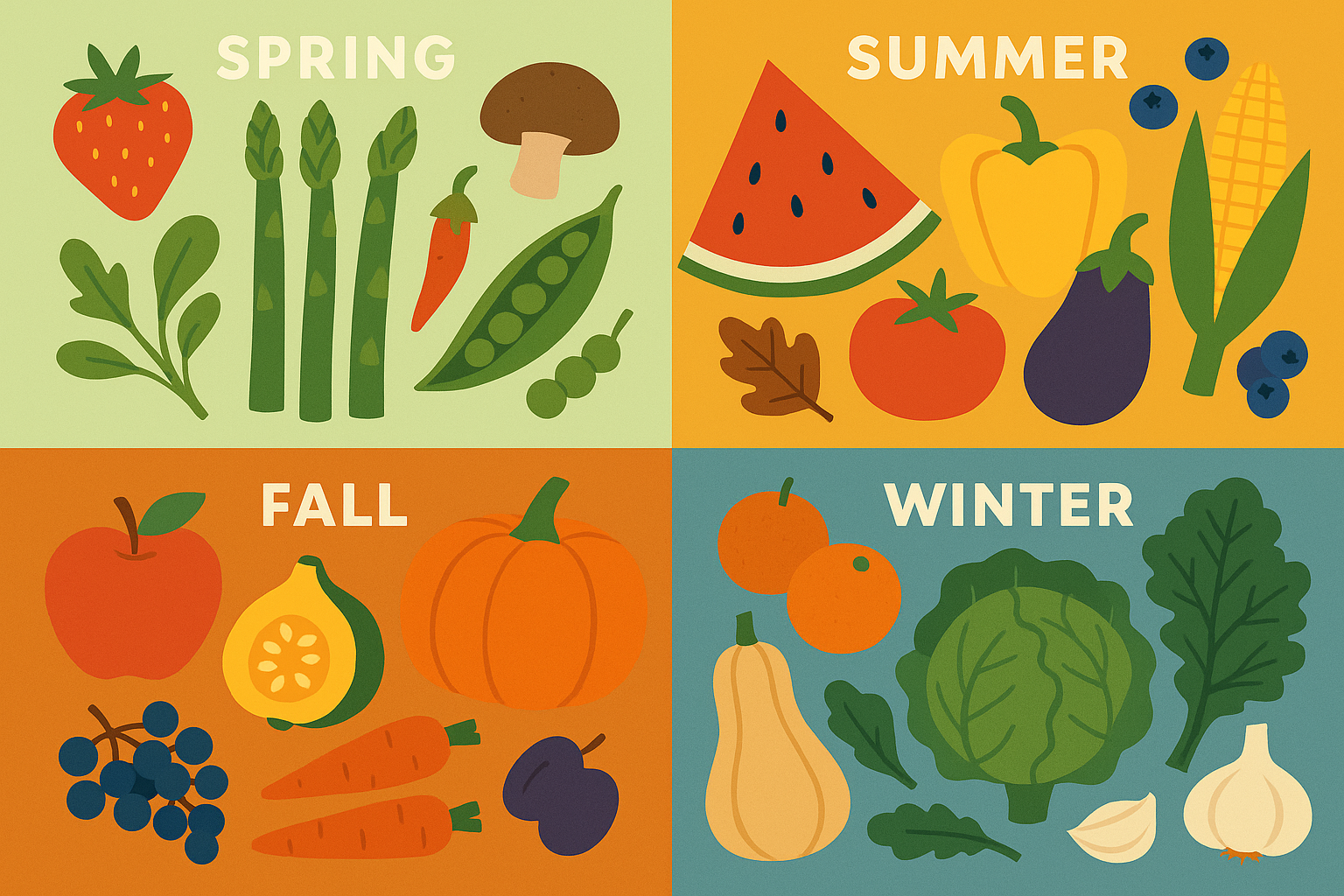
Turning Dinner Into Cultural Adventures Your Kids Actually Want
We tried “Italy Week” once. It lasted two days before my kids staged a revolt and demanded regular spaghetti. Now we just call it “trying new stuff Tuesday” and see what happens. Sometimes it’s a hit, sometimes we order pizza. Both outcomes are perfectly fine.
Children develop food preferences through stories and identity formation, making meal planning an opportunity to build cultural awareness rather than just meeting nutritional needs. When food comes with stories and context, kids become curious instead of resistant – most of the time.
Bringing Family History to the Dinner Table
I called my grandmother and asked her to walk me through her Depression-era recipes. Not for nostalgia – for survival wisdom. Those recipes were designed to maximize nutrition with minimal resources, and modern nutritionists would call them “complete meals,” but she just called them “what we had.”
Adapting traditional family recipes for modern needs while maintaining cultural significance creates deeper family connections and food appreciation – plus it gives you stories to tell when your kid inevitably asks “why do we have to eat this?”
Mining Your Family’s Food Stories
Her lentil soup recipe included ingredients I’d never thought to combine – lentils for protein, carrots for beta-carotene, onions for flavor and immune support, a ham bone for minerals. I’ve adapted her recipes for current food safety standards and my kids’ preferences, but kept the core nutritional wisdom.
The stories that come with these meals make kids more interested in trying them. “This is what Great-Grandma ate when she was your age” carries more weight than “eat your vegetables because I said so.”
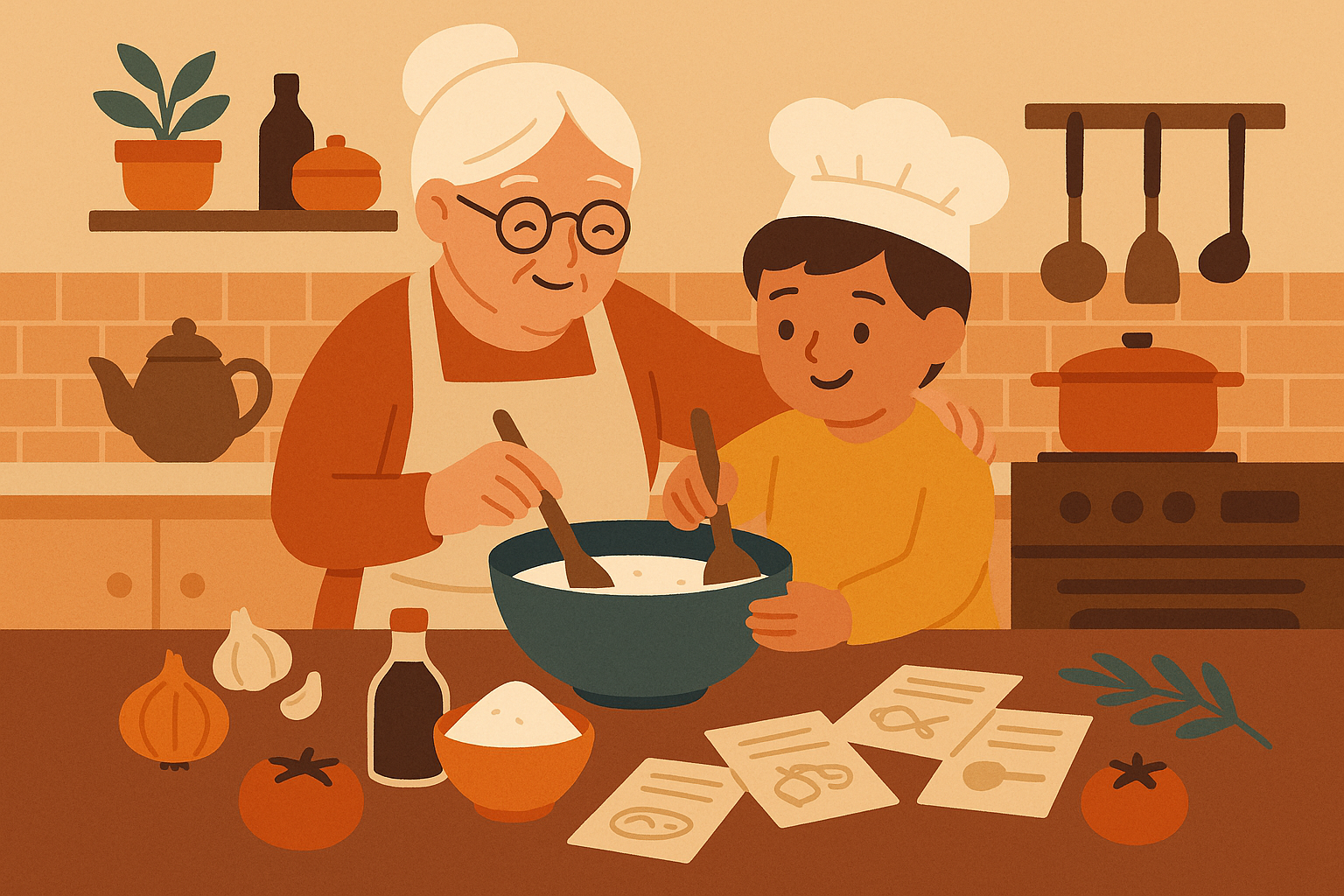
Creating New Traditions From Multiple Cultures
We do “potato week” where the same ingredient gets prepared according to different cultural traditions. Monday: German-style roasted potatoes. Tuesday: Indian aloo curry (mild version). Wednesday: Mexican papas con chorizo. Thursday: Japanese potato salad.
Same base ingredient, completely different flavor profiles. The kids learn that food preferences are cultural, not universal. They become more adventurous because they understand that “different” doesn’t mean “wrong” – just different from what we usually do.
Making Geography Delicious
“This week we’re eating our way through Italy.” Suddenly, trying new foods becomes exploration instead of obligation. I print simple maps, play music from each region, and share basic facts about the places we’re “visiting.”
Every meal becomes an opportunity for cultural education when food is presented within stories that children can understand and remember. Context makes unfamiliar foods feel adventurous rather than threatening.
Weekly Food Passport Adventures
The kids start asking questions about the countries, the people, why they eat certain foods. Food becomes a gateway to learning about the world instead of just fuel for their bodies.
“This week we’re eating our way through Italy” works better than “try this weird pasta shape.” Monday: Northern Italy with risotto (which is just creamy rice, kids). Tuesday: Central Italy with regular pasta they already like. Wednesday: Southern Italy with pizza night.
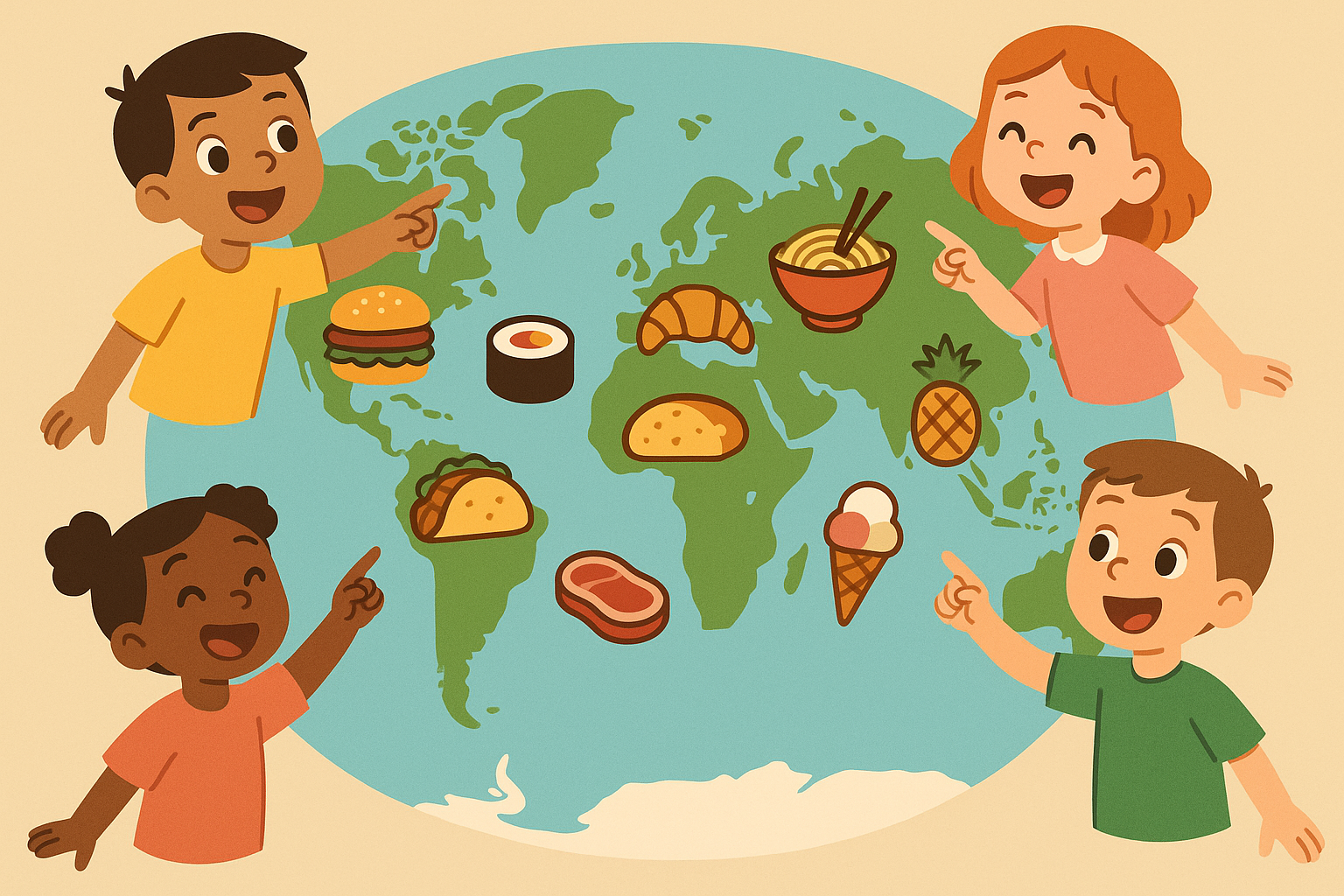
Time Travel Through Your Kitchen
“Medieval Monday” features hearty stews and bread (adapted for modern nutrition and safety, obviously). “Pioneer Tuesday” brings simple, preserved foods. “1950s Wednesday” explores the beginning of processed foods – which explains why Grandma loves her Jell-O salads.
Kids love the stories behind the food. Why did people eat certain things? How did they preserve food without refrigerators? What did kids their age eat 100 years ago? These meals become conversation starters about history, geography, and human ingenuity. Education disguised as dinner.
Research from BBC Good Food shows that meal plans designed for a family of four with two adult-sized portions and two half-sized children’s portions create the most sustainable approach to family feeding, allowing for flexibility in children’s varying appetites while maintaining nutritional consistency.
Building Meal Planning Habits That Stick (Even During Chaos)
I stopped trying to be a Pinterest mom with 30 different meal ideas. Instead, I identified 3 meal structures my family already loved and just switched up the ingredients. Turns out, being “boring” was actually the key to success.
Most meal planning systems fail because they require constant willpower and decision-making rather than building automatic systems that become effortless family routines. Sustainable systems work with human psychology and family chaos instead of against them.
The Minimum Effort, Maximum Results Approach
Last Tuesday, I burned the chicken, the kids refused the vegetables, and we ended up eating cereal for dinner. And you know what? Everyone survived. Sometimes good enough is actually good enough.
Creating the smallest possible system that delivers maximum results prevents overwhelm while building sustainable long-term habits that can survive sick days, busy seasons, and the occasional complete parenting meltdown.
Three Templates That Solve Everything
Template 1: Protein + roasted vegetables + grain
Template 2: Soup + bread + salad
Template 3: Pasta + vegetables + protein
That’s it. Every meal fits one of these templates. The variety comes from changing the specific ingredients, not the structure. Chicken and rice becomes salmon and quinoa becomes tofu and barley (though let’s be real, my kids prefer the chicken).
The kids know what to expect structurally, but there’s still surprise in the specific ingredients. Familiarity with novelty – exactly what developing brains crave and exactly what exhausted parent brains can handle.
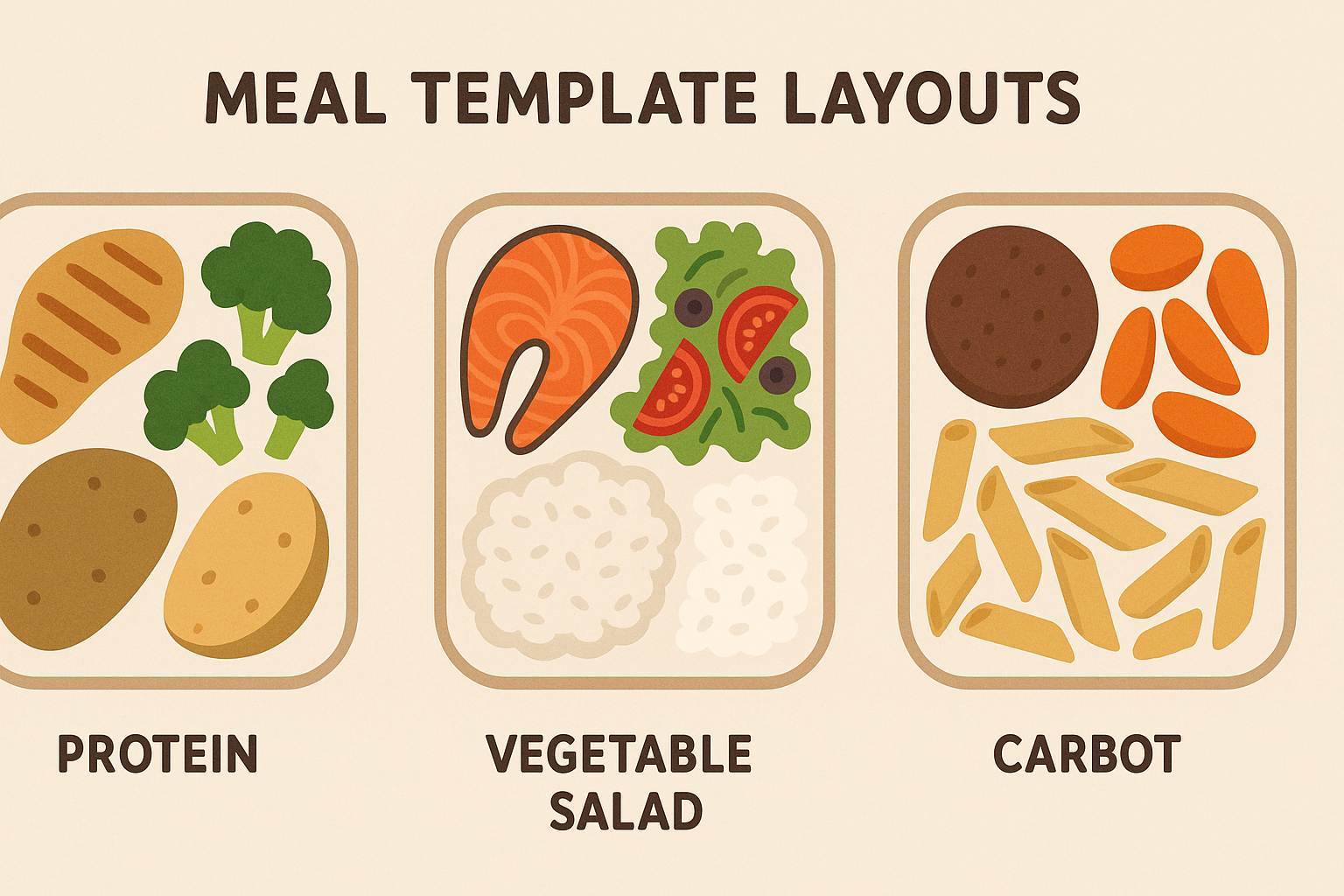
This template approach works especially well when combined with seasonal ingredients, and our guide to how to cook eggplant shows how one versatile vegetable can fit into multiple templates throughout your meal plan for the week.
Eliminating Decision Fatigue Before It Starts
Meatless Monday. Taco Tuesday. Leftover Wednesday. Pasta Thursday. Pizza Friday. Weekend wild cards.
Sounds boring? It’s actually liberating. No more 4 PM panic about dinner. No more grocery store wandering while your toddler has a meltdown in the cereal aisle. No more “what do you want to eat” negotiations that end with everyone frustrated.
The structure handles the big decisions, so I can focus energy on the details that matter – which vegetables to sneak in, how to prepare them so they might actually get eaten, what new ingredient to introduce this week.
I also prep ingredients immediately after grocery shopping. Vegetables get washed and chopped. Proteins get portioned and seasoned. Everything goes into clear containers with labels because I will not remember what that mystery container contains by Thursday.
Here’s my Sunday prep routine: 2 hours total while the kids watch screens (judge me, I don’t care). First hour: wash and chop all vegetables, portion proteins, cook grains in bulk. Second hour: assemble grab-and-go snacks, prep breakfast components, write the week’s menu on a whiteboard so my husband stops asking what’s for dinner every single day.
According to meal planning research from Because I Said So Baby, families who aim for 3-4 coordinated family meals per week rather than attempting identical meals seven nights weekly report significantly less stress and better food acceptance rates among children.
Getting Kids Involved Without Losing Your Mind
My 4-year-old takes pride in being the “official stirrer” – she doesn’t realize she’s learning about ingredient integration and following directions. She just knows she’s important to the dinner process, which makes her more invested in actually eating what we make.
Gradually increasing children’s involvement in meal planning and preparation builds life skills while reducing parental burden and increasing food acceptance. Kids are more likely to eat foods they helped prepare, even if your kitchen looks like a tornado hit it afterward.
Age-Appropriate Kitchen Responsibilities That Actually Help
Ages 3-5: They can wash vegetables (with supervision), stir ingredients in bowls, and set the table. Give them something to do that won’t drive you crazy but makes them feel important.
Ages 6-8: Measuring ingredients teaches math in disguise. Simple cutting with kid-safe knives builds motor skills. Reading recipes aloud improves literacy while making them feel crucial to the process.
Ages 9-12: They plan one complete meal per week, including shopping list creation. This teaches budgeting, nutrition awareness, and project management. My 10-year-old’s “taco bar night” has become a family favorite because he feels ownership over it.
Teens: Full meal responsibility one day per week, including budget management and nutrition research. They learn real-world skills while giving you a break. Plus, they’re more invested in family meals when they understand the actual work involved.
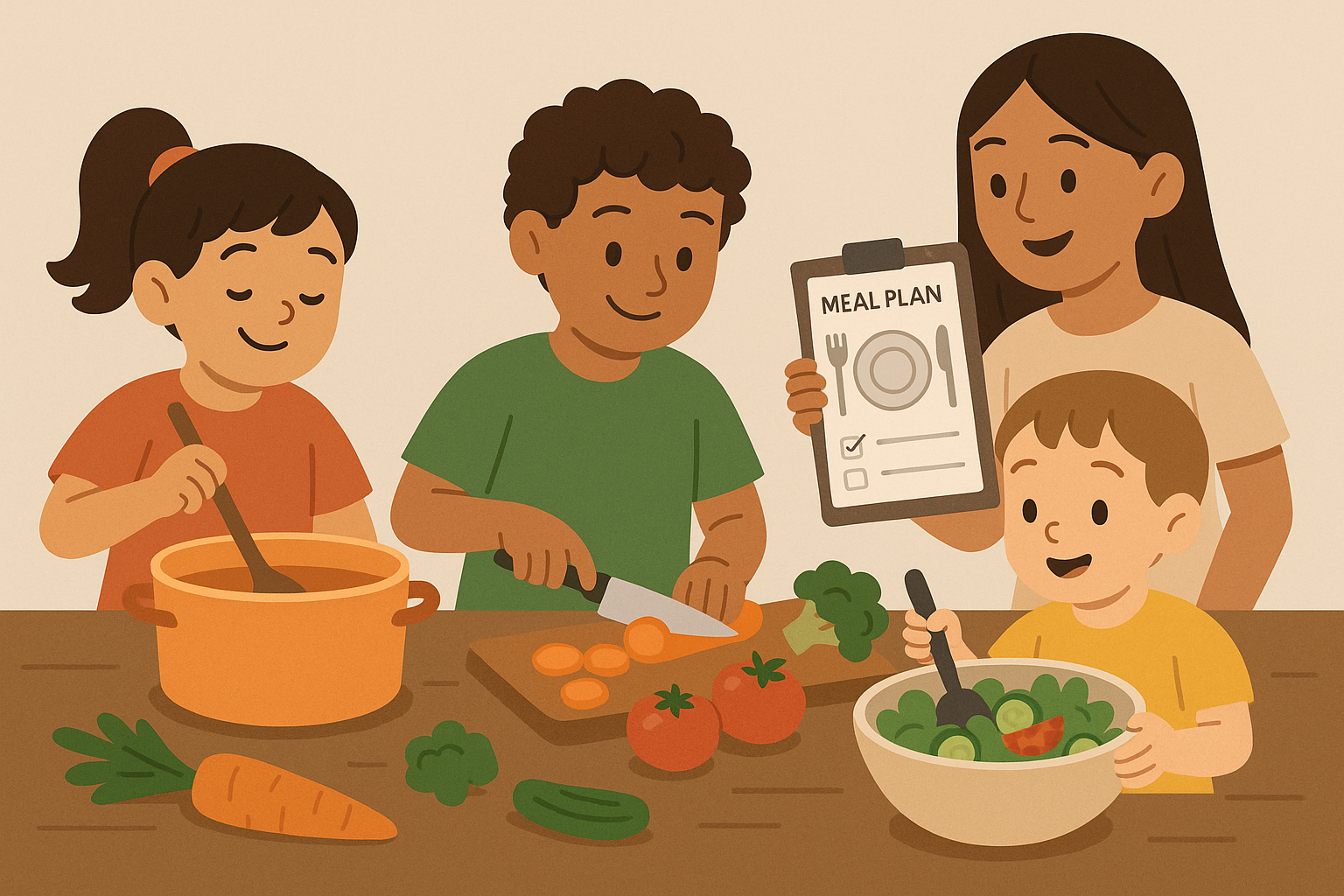
Teaching Through Cooking (Not Just Cooking)
I explain the “why” behind everything we do, because kids are naturally curious about processes they can observe. Why do we wash vegetables? (Bacteria removal) Why do onions make us cry? (Sulfur compounds) Why does bread rise? (Yeast biology – it’s like magic but with science)
When recipes don’t work perfectly (and they won’t), we problem-solve together. Too salty? Add acid or dairy. Too bland? More seasoning or aromatics. These troubleshooting moments teach critical thinking and resilience – skills they’ll need for way more than just cooking.
Food safety becomes natural when it’s integrated into cooking education instead of delivered as lectures. They learn proper handwashing, temperature control, and cross-contamination prevention through practice.

Final Thoughts
Some weeks, we eat more frozen pizza than I’d like to admit. Some weeks, my meal prep game is strong and I feel like a domestic goddess. Most weeks fall somewhere in between, and that’s perfectly okay.
Creating a sustainable 7-day weekly meal plan kid-friendly approach isn’t about perfection – it’s about understanding how children’s brains work and building systems that support your family’s unique needs and chaos level. The science behind food acceptance, combined with practical batch cooking strategies and cultural integration, creates a framework that grows with your family while reducing daily stress.
The biggest revelation for me was realizing that “picky eating” isn’t a character flaw – it’s neurobiology. Once I started working with my kids’ natural development instead of against it, mealtimes transformed from battlegrounds into opportunities for connection and learning. Most of the time, anyway.
Your 7-day meal planning doesn’t need to look like anyone else’s Instagram feed. The templates and strategies I’ve shared work because they’re based on how families actually function when everyone’s tired and someone forgot to defrost the chicken, not how we think they should function in our Pinterest dreams.
Start with one or two concepts that resonate with your current situation, then build from there. Maybe it’s just putting the same vegetable on your kid’s plate three times this week without any expectations. Maybe it’s batch cooking one protein on Sunday. Maybe it’s just accepting that cereal for dinner occasionally won’t ruin your child’s future.
The goal isn’t to become a meal planning expert overnight or to have a perfectly curated food blog life. It’s to create sustainable systems that make feeding your family easier, more nutritious, and more enjoyable. When you remove the daily decision fatigue and work with your children’s natural food acceptance patterns instead of fighting them, you’ll find that family meals become something you actually look forward to – at least most of the time.
Remember, every family’s journey with food is different, and comparison is the thief of joy (and sanity). What matters is finding approaches that honor your children’s development, respect your time and budget constraints, and create positive associations with family meals that will last a lifetime. Even if those meals sometimes involve chicken nuggets and you calling it a win.
If your kid survives on the same three foods for a month, they’ll be fine. I’ve served cereal for dinner more times than I can count, and my kids are healthy, happy, and slowly expanding their food horizons. Progress, not perfection – that’s the real secret to sustainable family meal planning.
If you’re looking for high-quality, family-friendly ingredients to support your meal planning journey, Organic Authority’s carefully curated selection of organic and clean products can help you implement these strategies with confidence. Their commitment to transparency and quality means you can focus on the cooking and connecting, knowing your ingredients meet the highest standards for your family’s health.

